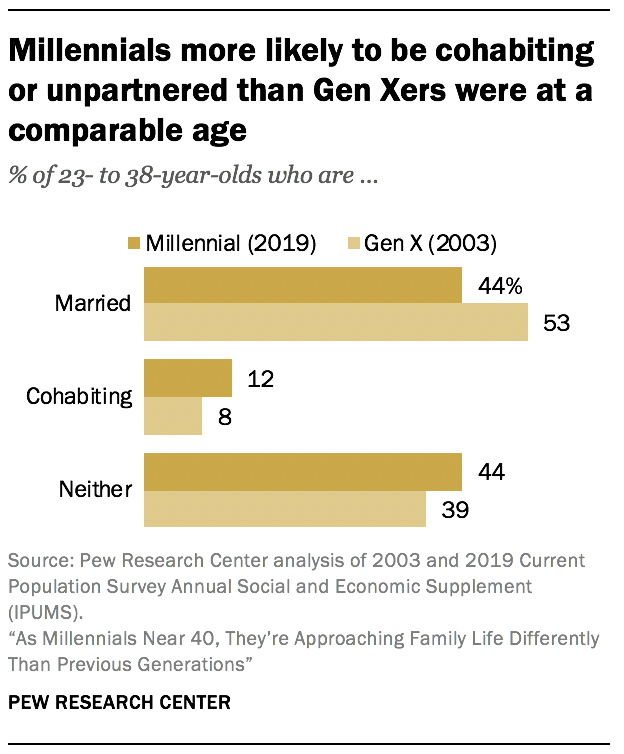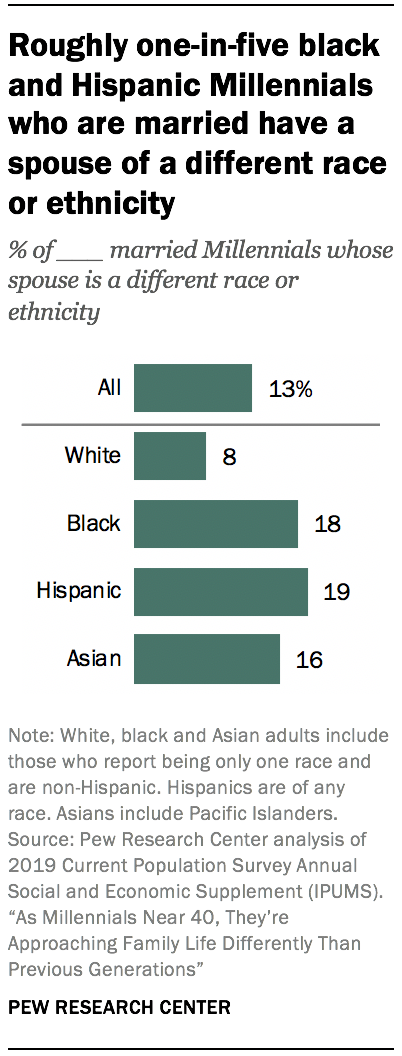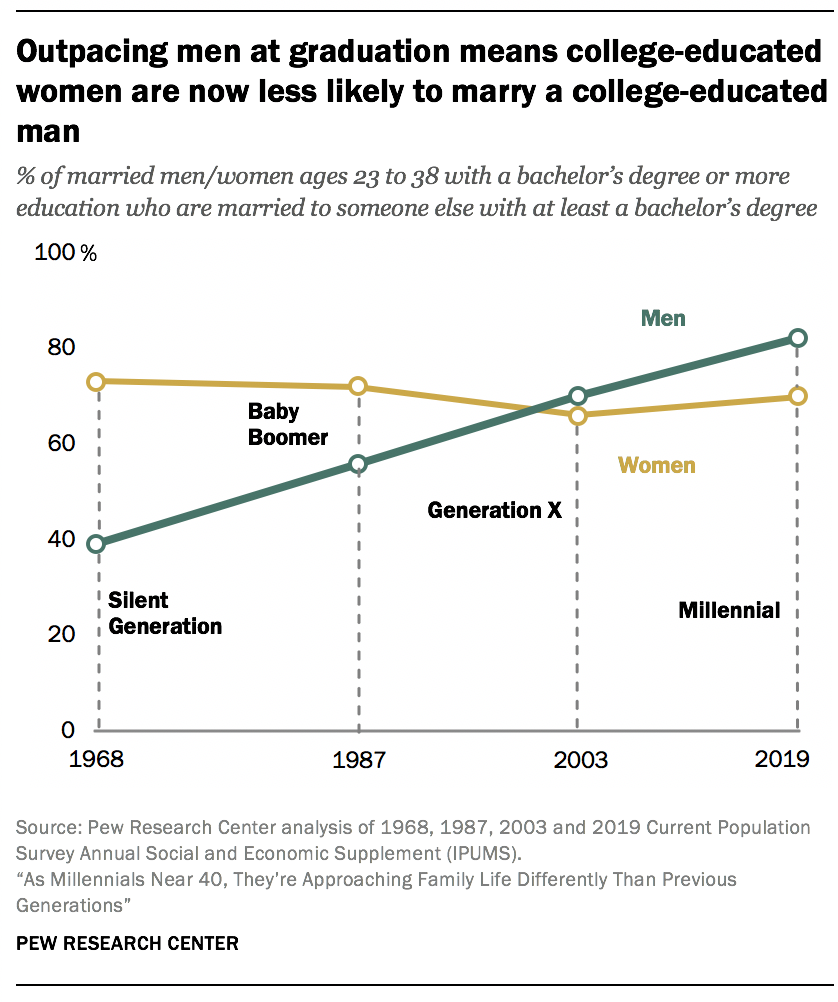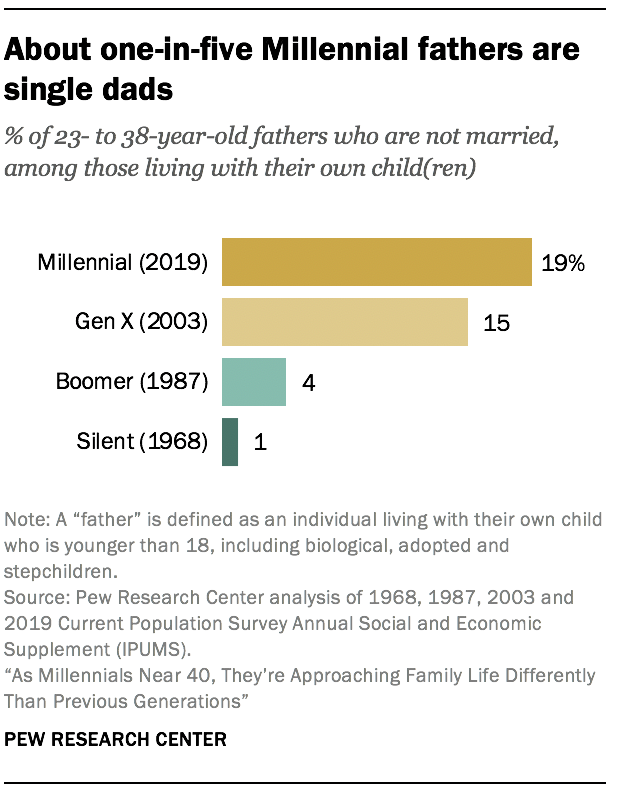ogc163
Superstar
As Millennials reach a new stage of life – the oldest among them will turn 39 this year – a clearer picture of how members of this generation are establishing their own families is coming into view. Previous research highlights not only the sheer size of the Millennial generation, which now surpasses Baby Boomers as the largest, but also its racial and ethnic diversity and high rates of educational attainment. This research also notes that Millennials have been slower than previous generations to establish their own households.
A new analysis of government data by Pew Research Center shows that Millennials are taking a different path in forming – or not forming – families. Millennials trail previous generations at the same age across three typical measures of family life: living in a family unit, marriage rates and birth rates.
Millennials are less likely to live with a family of their own than previous generations were at the same stage of life
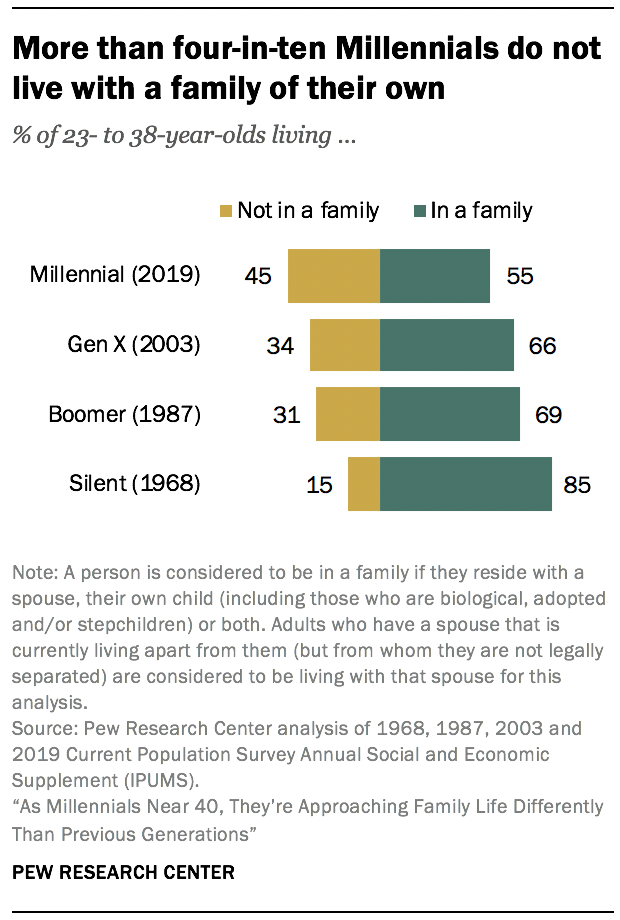
Living with a family is defined here as living with a spouse, one’s own child (or children) or both a spouse and child. Using this definition, Millennials are much less likely to be living with a family of their own than previous generations when they were the same age. In 2019, 55% of Millennials lived in this type of family unit. This compares with 66% of Gen Xers in 2003, 69% of Boomers in 1987 and 85% of members of the Silent Generation in 1968.
Millennials lag furthest behind in the share living with a spouse and child. Only three-in-ten Millennials fell into this category in 2019, compared with 40% of Gen Xers, 46% of Boomers and 70% of Silents when they were the age Millennials are now. At the same time, the share of Millennials who live with a spouse and no child is comparable to previous generations (13%), while the share living with a child but no spouse (12%) is the same as Gen X but higher than Boomers and Silents.
Among Millennials, there are significant differences in the share living in a family of their own by race, ethnicity and educational attainment. Black Millennials are the least likely to live in a family – 46% do, compared with 57% of white and Hispanic Millennials and 54% of Asians. Black Millennials are more likely than other groups to live with a child and no spouse (22%, compared with 16% of Hispanic, 9% of white and 4% of Asian Millennials).
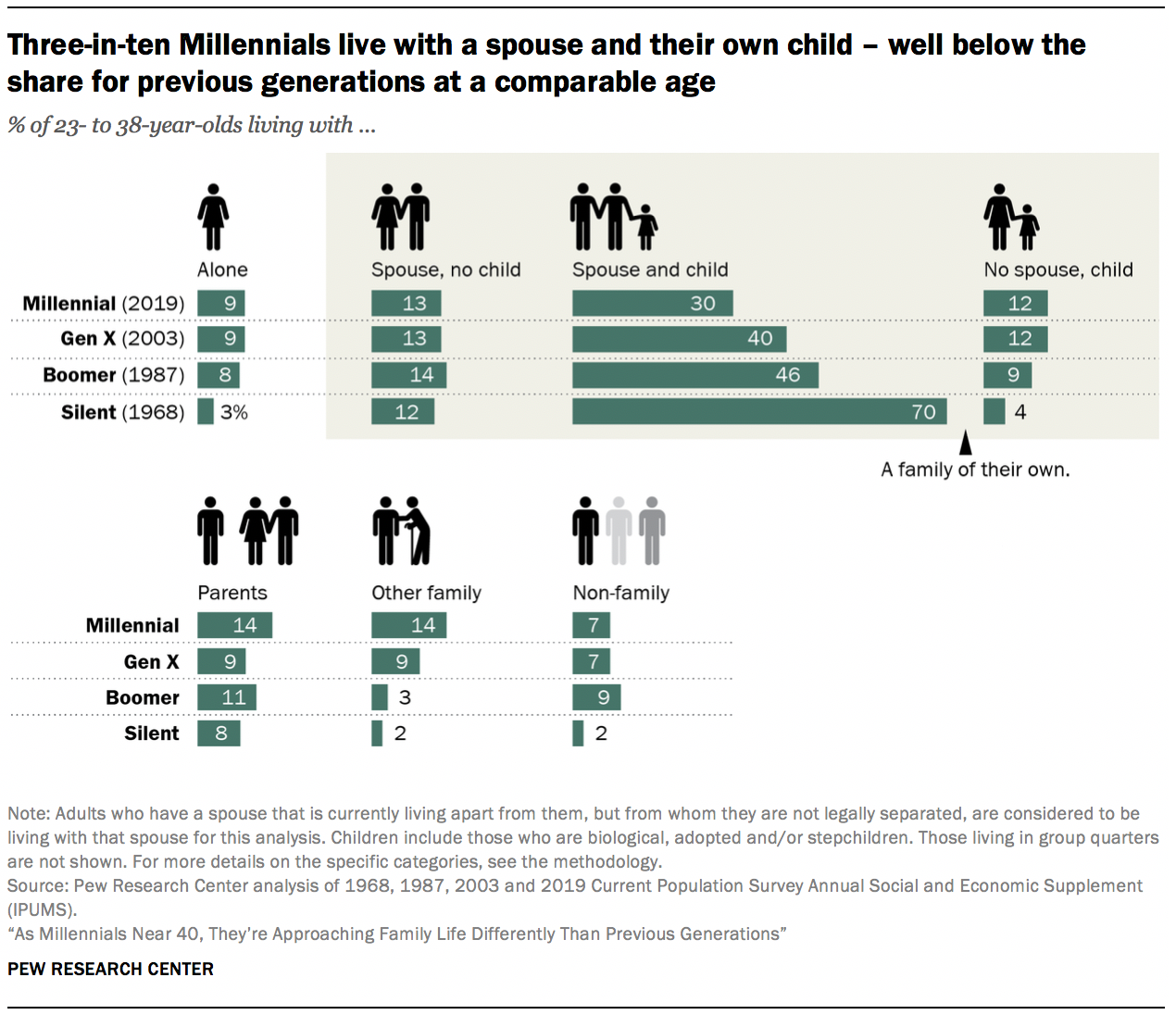
Overall, Millennials with less than a high school diploma are more likely than those with more education to live in a family (63% compared with 55% each of high school graduates, those with some college education and college graduates).
Millennials with a bachelor’s degree or more education are more likely than those with less education to live with a spouse and no child (18% compared with 11% of those with some college education, 10% of high school graduates, and 7% of those with less than a high school diploma). College-educated Millennials are the least likely to live with a child and no spouse (4%), while those with less than a high school education are the most likely to fall into this category (21%).
A look at Millennials who aren’t living with a family of their own reveals that most live in other family arrangements: 14% of Millennials live with their parents, and another 14% live with other family members. In both cases, these shares are higher than for other generations when they were in their 20s and 30s. Previous research has shown that, even after the economy started to recover from the Great Recession, the share of Millennials living in their parents’ homes continued to rise. Millennial men are much more likely than Millennial women to live with their parents (18% of men compared with 10% of women). Millennial men without a college degree are especially likely to fall into this category (21%, compared with 12% of Millennial men with a bachelor’s or higher degree).
About one-in-ten Millennials (9%) live alone. This is similar to the share of Gen Xers and Boomers who did so at a comparable age but higher than the share of Silents. Some 7% of Millennials live in a household with non-family members.
median age at first marriage has edged up gradually in recent decades. In 2019, the average man first got married at age 30, and the average woman was 28 when she first wed. This is three years later – for both men and women – than in 2003, four years later than in 1987 and seven years later than in 1968.
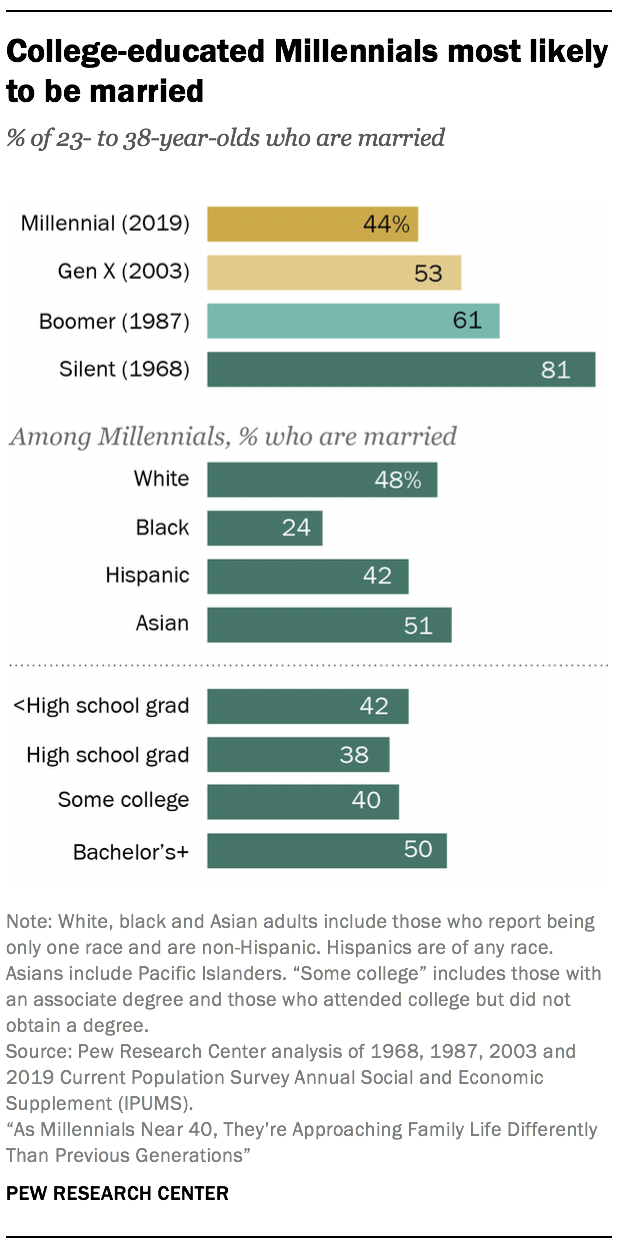
Black Millennials are far less likely to be married than Millennials in other racial and ethnic groups: 24% compared with 51% of Asian, 48% of white and 42% of Hispanic Millennials. This racial and ethnic pattern is similar for older generations, but the gap between black adults and other groups has widened since 1968.
Half of all Millennials with a bachelor’s degree or more education are married, which is higher than the share among those with less education. The largest gap emerges when comparing the shares of Millennials with a bachelor’s degree (50%) and those with a high school education (38%) who are married. There’s a 10-point gap in the share married between those with a bachelor’s degree and those with some college education (40%). Some 42% of Millennials with less than a high school education are married.
The education gap in marriage, which has been growing over time, is wider for Millennials than it has been in previous generations. Overall, marriage rates have declined since 1970, and the sharpest declines have been amongst the least educated adults.
A new analysis of government data by Pew Research Center shows that Millennials are taking a different path in forming – or not forming – families. Millennials trail previous generations at the same age across three typical measures of family life: living in a family unit, marriage rates and birth rates.
Millennials are less likely to live with a family of their own than previous generations were at the same stage of life

Living with a family is defined here as living with a spouse, one’s own child (or children) or both a spouse and child. Using this definition, Millennials are much less likely to be living with a family of their own than previous generations when they were the same age. In 2019, 55% of Millennials lived in this type of family unit. This compares with 66% of Gen Xers in 2003, 69% of Boomers in 1987 and 85% of members of the Silent Generation in 1968.
Millennials lag furthest behind in the share living with a spouse and child. Only three-in-ten Millennials fell into this category in 2019, compared with 40% of Gen Xers, 46% of Boomers and 70% of Silents when they were the age Millennials are now. At the same time, the share of Millennials who live with a spouse and no child is comparable to previous generations (13%), while the share living with a child but no spouse (12%) is the same as Gen X but higher than Boomers and Silents.
Among Millennials, there are significant differences in the share living in a family of their own by race, ethnicity and educational attainment. Black Millennials are the least likely to live in a family – 46% do, compared with 57% of white and Hispanic Millennials and 54% of Asians. Black Millennials are more likely than other groups to live with a child and no spouse (22%, compared with 16% of Hispanic, 9% of white and 4% of Asian Millennials).

Overall, Millennials with less than a high school diploma are more likely than those with more education to live in a family (63% compared with 55% each of high school graduates, those with some college education and college graduates).
Millennials with a bachelor’s degree or more education are more likely than those with less education to live with a spouse and no child (18% compared with 11% of those with some college education, 10% of high school graduates, and 7% of those with less than a high school diploma). College-educated Millennials are the least likely to live with a child and no spouse (4%), while those with less than a high school education are the most likely to fall into this category (21%).
A look at Millennials who aren’t living with a family of their own reveals that most live in other family arrangements: 14% of Millennials live with their parents, and another 14% live with other family members. In both cases, these shares are higher than for other generations when they were in their 20s and 30s. Previous research has shown that, even after the economy started to recover from the Great Recession, the share of Millennials living in their parents’ homes continued to rise. Millennial men are much more likely than Millennial women to live with their parents (18% of men compared with 10% of women). Millennial men without a college degree are especially likely to fall into this category (21%, compared with 12% of Millennial men with a bachelor’s or higher degree).
About one-in-ten Millennials (9%) live alone. This is similar to the share of Gen Xers and Boomers who did so at a comparable age but higher than the share of Silents. Some 7% of Millennials live in a household with non-family members.
median age at first marriage has edged up gradually in recent decades. In 2019, the average man first got married at age 30, and the average woman was 28 when she first wed. This is three years later – for both men and women – than in 2003, four years later than in 1987 and seven years later than in 1968.

Black Millennials are far less likely to be married than Millennials in other racial and ethnic groups: 24% compared with 51% of Asian, 48% of white and 42% of Hispanic Millennials. This racial and ethnic pattern is similar for older generations, but the gap between black adults and other groups has widened since 1968.
Half of all Millennials with a bachelor’s degree or more education are married, which is higher than the share among those with less education. The largest gap emerges when comparing the shares of Millennials with a bachelor’s degree (50%) and those with a high school education (38%) who are married. There’s a 10-point gap in the share married between those with a bachelor’s degree and those with some college education (40%). Some 42% of Millennials with less than a high school education are married.
The education gap in marriage, which has been growing over time, is wider for Millennials than it has been in previous generations. Overall, marriage rates have declined since 1970, and the sharpest declines have been amongst the least educated adults.
